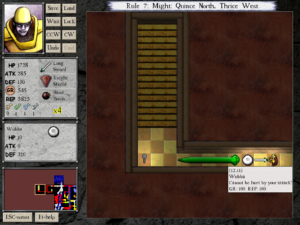DROD RPG: Monsters
Let’s take a moment to examine how the monsters of DROD were adapted for DROD RPG. The main thing that distinguishes the monsters from each other in the original game is how they move: roaches and tar babies charge straight at you, roach queens flee, evil eyes stay still until you cross their line of sight, goblins try to avoid your sword and attack you from behind, rock golems tend to get stuck on obstacles that other monsters are smart enough to go around, and so forth. Well, in DROD RPG, monsters don’t move. They just stand there blocking passageways until you decide to fight them. So, that’s a whole lot of distinguishing characteristics scrapped. As a result, most of the monsters are pretty much the same thing with different stats.
Mind you, that’s something that a game of this sort really needs. Like most RPGs, it’s all about the steady escalation of power. The game weirdly abstracts away some of the escalation effect by simply giving each level a multiplier that affects all potions and power-ups on that level, but I suppose applying it to monsters stats as well would be more honesty than the genre could bear. At any rate, the developers seem to have needed more gradations of monster stat than easily fit onto the set of original DROD monsters, and have crammed in some extras, repurposing some of Beethro’s puzzle-solving tools such as the fegundo and the decoy as monsters, as well as making up more powerful versions of existing monsters. It all reminds me a little of Star Wars-based games such as Dark Forces that have you fight things like the the Interrogation Droid and the Imperial Probot that appeared in the films in brief non-combatant roles.
There is still some variation of behavior, though. Some monsters, such as the evil eye, take a swing at you automatically when you pass right in front of them. People with swords get an extra attack in at the beginning of combat if you have to go through the sword to get at them, as is sometimes the case. Of all the creatures I’ve seen, the one that comes closest to its original form is the Aumtlich, which still has its deadly screen-crossing eyebeams. They don’t have the same effect at they did on Beethro — instead of freezing you in place, walking through the beam drains half your hit points, which is yet another example of stats substituting for movement. But at least it’s using the room geometry, and there are some puzzles made from it.
The creatures called “brains” are another notable special case. As in the original, they’re not powerful combatants themselves, but they make all the other monsters in the room more formidable. Again, stats take the place of movement: where the DROD brains gave the monsters access to a pathing algorithm, the DROD RPG ones double their attack strength.
 Then there’s wubbas. Wubbas are essentially giant fluffly marshmallows, impossible to destroy with a sword. They’re harmless, but only in the sense that they can’t damage you. In Journey to Rooted Hold, where they first showed up, they often thronged around Beethro until he couldn’t move and had to start the room over. I’ve only seen one wubba so far in DROD RPG, where it was standing guard over a semi-secret hallway. The interesting thing is that its invulnerability wasn’t a special property: instead, it simply had a very high defense stat. In theory, you could kill it with a sword if you found enough power-ups, although I don’t think enough exist in Chapter 1. Still, there just might be a way past it by using special items. In fact, I’d have enough attack power to get by it if I only had the Slayer’s hook that I can see tantalizingly discarded in an inaccessible part of one room. I’ll talk about that more in my next post.
Then there’s wubbas. Wubbas are essentially giant fluffly marshmallows, impossible to destroy with a sword. They’re harmless, but only in the sense that they can’t damage you. In Journey to Rooted Hold, where they first showed up, they often thronged around Beethro until he couldn’t move and had to start the room over. I’ve only seen one wubba so far in DROD RPG, where it was standing guard over a semi-secret hallway. The interesting thing is that its invulnerability wasn’t a special property: instead, it simply had a very high defense stat. In theory, you could kill it with a sword if you found enough power-ups, although I don’t think enough exist in Chapter 1. Still, there just might be a way past it by using special items. In fact, I’d have enough attack power to get by it if I only had the Slayer’s hook that I can see tantalizingly discarded in an inaccessible part of one room. I’ll talk about that more in my next post.
 Comments(1)
Comments(1)
Hehe, if only you knew…